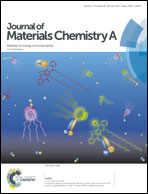New series of soft materials based on ionic liquid–metal complexes for high-efficient electrolytes of dye-sensitized solar cells†
Abstract
A new series of soft materials were successfully achieved by a simple synthetic method in water. The coordination reactions of task-specific ionic liquid with different metal oxides were systematically investigated and analyzed. The obtained ten ionic liquid–metal complexes (ILMCs) were developed for efficient electrolytes for dye-sensitized solar cells (DSCs). ILMC-based DSCs exhibit superior photovoltaic performance and the remarkable increases in efficiencies with a multiple of 1.46–2.63 compared with an ionic liquid (IL) electrolyte without a metal center. The mechanism investigations clarified the influences of different metal centers on the conversion efficiencies of the corresponding devices. The high conductivity and diffusion coefficient of I3−, inhibited electron recombination and low charge transfer impedance contribute to the superior photovoltaic performance of ILMC electrolytes. The new concept, simple composition, high conductivity and conversion efficiency along with an easy fabrication method qualify the ILMC-based soft materials as promising high-efficient alternative electrolytes of DSCs.



 Please wait while we load your content...
Please wait while we load your content...